
Insofar as illustrating a manuscript goes, this image isn’t a very good fit, but I happened to like it and it was among the first images that I got for this session, so here it is. This is a black vulture (Coragyps atratus) looking down on us suspiciously as we slipped in underneath.
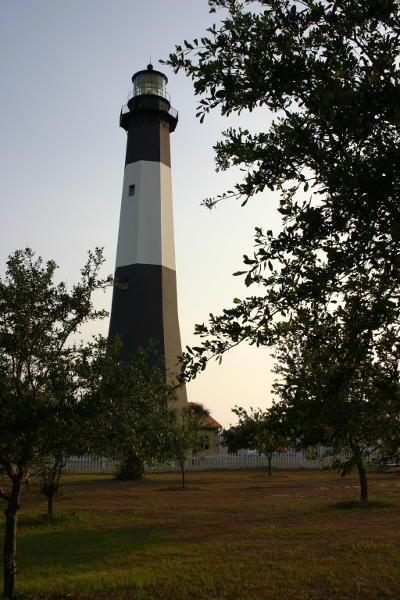 The “us” in this case is The Girlfriend, The Girlfriend’s Sprog, and I, and the locale is outside of Savannah, Georgia, because this past week was our scheduled trip to Savannah and Jekyll Island. It was intended to be just shy of an entire week, Saturday to Friday, but Hurricane Florence changed that as it strengthened and aimed for the coast, and we spent a lot of time debating whether our plans would change, and in what way. I have to point out that last year’s scheduled trip to the same places was canceled outright due to Hurricane Irma’s landfall directly on Jekyll, which closed the island, so this was starting to get annoying. And yes, feel free to blame us for picking these times, but there’s more than casual reasoning behind it: the goal was to catch sea turtle hatching season, which occurs for about six weeks right around this time, plus we’d aimed for after Labor Day to take advantage of lower rates, lesser crowds, and better traffic. But yeah, it seems we’ve learned our lesson now. It doesn’t help that, as I type this back home in North Carolina, Florence (now a Tropical Storm,) is centered fewer than 200 kilometers away and producing less rain and winds than some of the spring storms this year. I’m sure some areas are catching it a lot worse, but not where we were or on our return path; we could have ignored the storm and not seen anything except for some rainy driving on the trip back, but there was no way we could have known that for sure. The news reports concentrated on the dramatic aspects and not on an accurate picture of what was really happening, surprise surprise.
The “us” in this case is The Girlfriend, The Girlfriend’s Sprog, and I, and the locale is outside of Savannah, Georgia, because this past week was our scheduled trip to Savannah and Jekyll Island. It was intended to be just shy of an entire week, Saturday to Friday, but Hurricane Florence changed that as it strengthened and aimed for the coast, and we spent a lot of time debating whether our plans would change, and in what way. I have to point out that last year’s scheduled trip to the same places was canceled outright due to Hurricane Irma’s landfall directly on Jekyll, which closed the island, so this was starting to get annoying. And yes, feel free to blame us for picking these times, but there’s more than casual reasoning behind it: the goal was to catch sea turtle hatching season, which occurs for about six weeks right around this time, plus we’d aimed for after Labor Day to take advantage of lower rates, lesser crowds, and better traffic. But yeah, it seems we’ve learned our lesson now. It doesn’t help that, as I type this back home in North Carolina, Florence (now a Tropical Storm,) is centered fewer than 200 kilometers away and producing less rain and winds than some of the spring storms this year. I’m sure some areas are catching it a lot worse, but not where we were or on our return path; we could have ignored the storm and not seen anything except for some rainy driving on the trip back, but there was no way we could have known that for sure. The news reports concentrated on the dramatic aspects and not on an accurate picture of what was really happening, surprise surprise.
So here’s the result: we had Sunday, mostly spent on Tybee Island off the coast of Savannah, then a lazy day Monday before we finally headed down to Jekyll, and Tuesday on Jekyll, before we decided to call it quits and headed back up early Wednesday morning. That’s only two days of activities – and for me, shooting, which nonetheless resulted in over a thousand frames, so even though it was way shorter than intended and we returned to crappy weather, I accomplished a decent amount, which will be spread over at least two posts – I’m not sure exactly how I’m going to tackle some of the subjects yet.
I don’t travel with the idea that I’m going to write it all up, and I don’t do the tourist thing, and I detest social media, so I often find myself without illustrating or establishing shots, which is my way of saying that this image of the lighthouse on Tybee Island comes from a previous visit seven years ago, despite the fact that we actually went up into the lighthouse this time around. Tybee has a checkered history that you should look up if you have the faintest interest, but overall, it’s a quiet (this time of year, anyway) little resort island with some historical significance and, more importantly for our purposes, close to Savannah and interesting enough for a day trip. The Tybee Island Marine Science Center is small but definitely pretty cool and worth the modest admission fee, the fort is more like a complex with only one portion being maintained as a museum, and the lighthouse is, well, a lighthouse: hard slog up the steps (especially with the injured foot that I’d been desperately trying to let heal before the trip, but oh well,) and a nice view of the island which was mostly trees, houses, and beach. It’s not like the view from 43 meters up is especially spectacular.
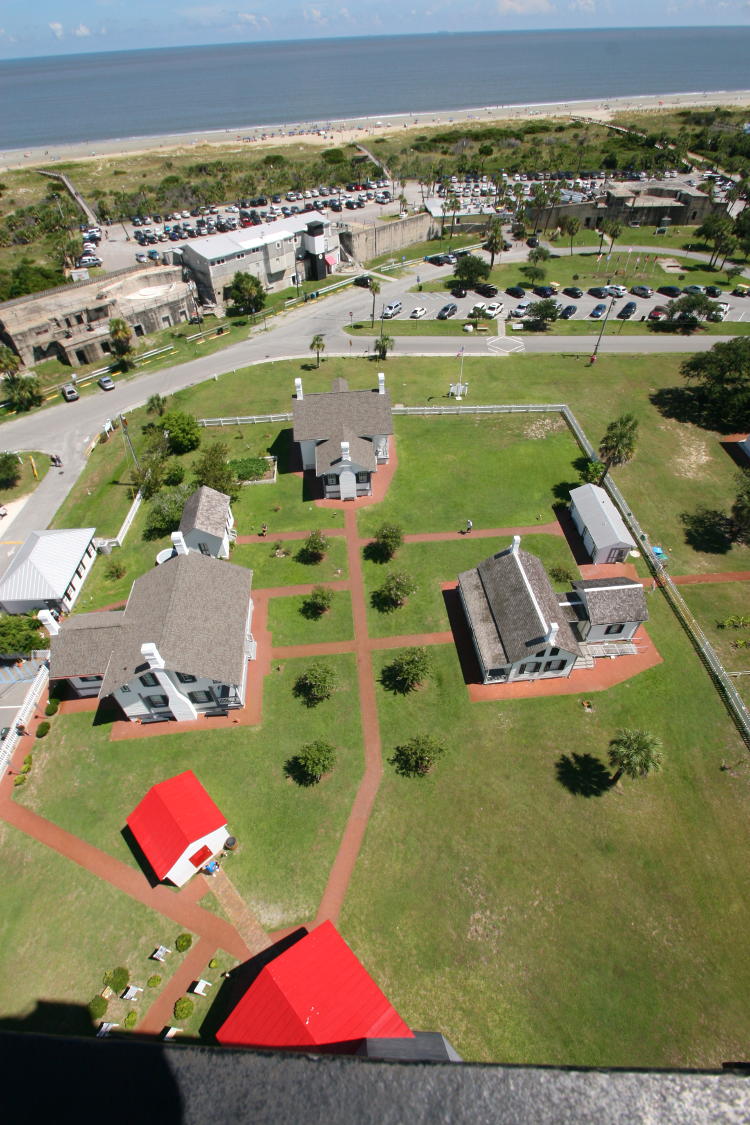
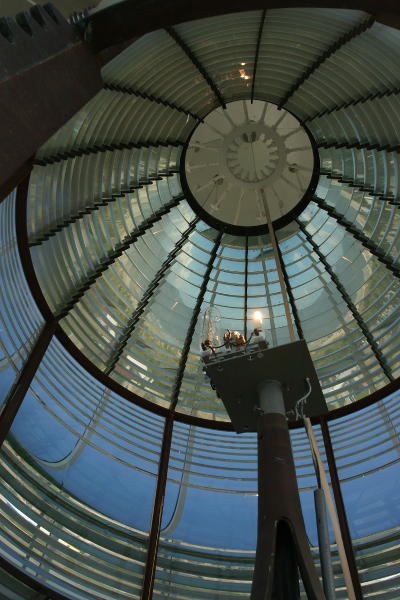 Those are the original lighthouse complex buildings in the foreground, with Fort Screven in the middle ground and the historic Atlantic Ocean in the rear. Somewhere off to the far right (not the photo to the immediate right) sits a nuclear bomb, jettisoned from a bomber back in 1958, but we didn’t get to see that.
Those are the original lighthouse complex buildings in the foreground, with Fort Screven in the middle ground and the historic Atlantic Ocean in the rear. Somewhere off to the far right (not the photo to the immediate right) sits a nuclear bomb, jettisoned from a bomber back in 1958, but we didn’t get to see that.
To the immediate right sits my response to the challenge, issued about an hour beforehand, to work on my art – this is the light and lens assembly of the lighthouse. Now let me point out something cool: This is shooting almost straight up from the floor of the lamp room, so the lenses forming the circle at the top of the frame are in a dome above the lamp, re-aiming the light to shine out to sea (why is it never “to ocean” in such phrases?) From this vantage, however, they’re doing a pretty good job of showing the surrounding landscape that sits well below the lighthouse, probably somewhere around a 120-150° angle away. The bulb you see burning isn’t the main light, but what I take is a decorative thing; the main light is the bulb to the left of it and a hell of a lot brighter than this.
We’d looked into taking a sunset dolphin tour while out there, but they were booked full by the time that we contacted them, so we settled for poking around a little near the causeway onto the island. Tybee has another lighthouse called Cockspur, so named because it’s out on the end of the ‘leg’ of Tybee Island like the spur on the leg of a rooster, and not what you were thinking. Actually I have no real idea where the name came from, but that is indeed what a cockspur is. We would have visited that one too but they hadn’t adequately planned the parking when building it, as you can see:
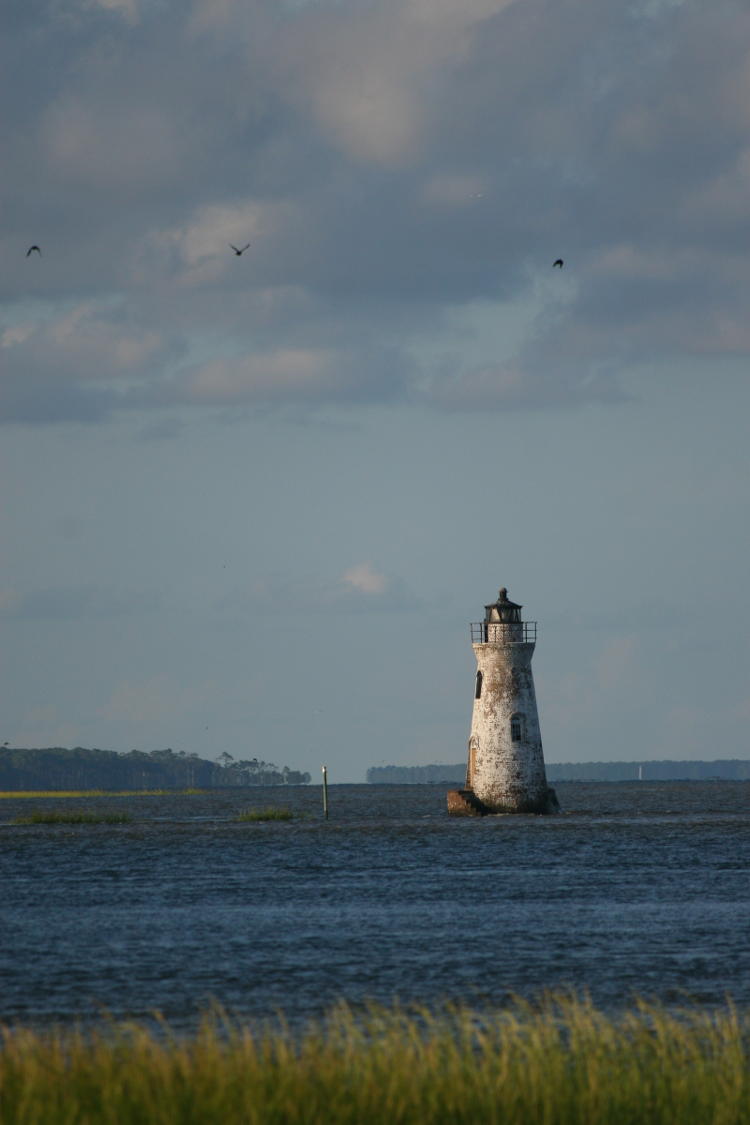
 While shooting it with the 100-300 L lens, some birds helpfully played around in the frame, lending some points of interest and ‘setting’ to the sky. Attempting these kinds of compositions can be a little taxing to anyone you’re hanging with, especially if they’re not trying for the same thing, because while plenty of birds might be flying around, having one pass precisely through the prime portion of the frame is difficult enough, but having the light right and the wings in a good position is strictly hit-or-miss, much more often miss. Trust me – I did it enough on this trip. You never realize how easy it is for a bird to be in a cluttered portion of the frame, or in a boring flat glide right when you want the wings up, until you’re patiently waiting for them to fill out your intended composition. But while you’re staring through the viewfinder or watching the birds within the immediate vicinity, thinking, Any second now, your companions are watching you shoot nothing and wondering how much longer this is going to take. “C’mon, you can shoot nothing from home!”
While shooting it with the 100-300 L lens, some birds helpfully played around in the frame, lending some points of interest and ‘setting’ to the sky. Attempting these kinds of compositions can be a little taxing to anyone you’re hanging with, especially if they’re not trying for the same thing, because while plenty of birds might be flying around, having one pass precisely through the prime portion of the frame is difficult enough, but having the light right and the wings in a good position is strictly hit-or-miss, much more often miss. Trust me – I did it enough on this trip. You never realize how easy it is for a bird to be in a cluttered portion of the frame, or in a boring flat glide right when you want the wings up, until you’re patiently waiting for them to fill out your intended composition. But while you’re staring through the viewfinder or watching the birds within the immediate vicinity, thinking, Any second now, your companions are watching you shoot nothing and wondering how much longer this is going to take. “C’mon, you can shoot nothing from home!”
Meanwhile, here we have a laughing gull (Leucophaeus atricilla) openly mocking us. How, you ask? Because it’s already in winter plumage, jumping the gun worse than department stores. Hey, shithead, those of us without feathers are still getting sunburned, and the water temperature’s perfect for swimming! Just because Labor Day has passed…
I got to be out shooting for two sunsets and a sunrise on this brief trip (two sunrises were viewed from the car while out on the road,) and all of them occurred with scattered thunderheads and tempestuous storm clouds obscuring the sun, right down near the horizon. Now, higher in the sky, or off to the sides (as you will eventually see,) these can become lit by the sun for some nice colorful effects, but when blocking the sun they greatly limit the opportunities. Nonetheless, there were a couple of patches that had promise and I dutifully worked with these as best I could. This particular evening the sky looked more like an old canvas used for cleaning brushes, but I tracked every bird that looked like it might pass in front of the interesting bits; I was, naturally, hoping for a pelican, but they stubbornly avoided the best regions of the sky. But when another gull was cruising through, I panned with it and fired off numerous frames, and finally selected this one (cropped a bit) as fitting within my fartistic standards; I’ll let you decide if those should be higher or not:
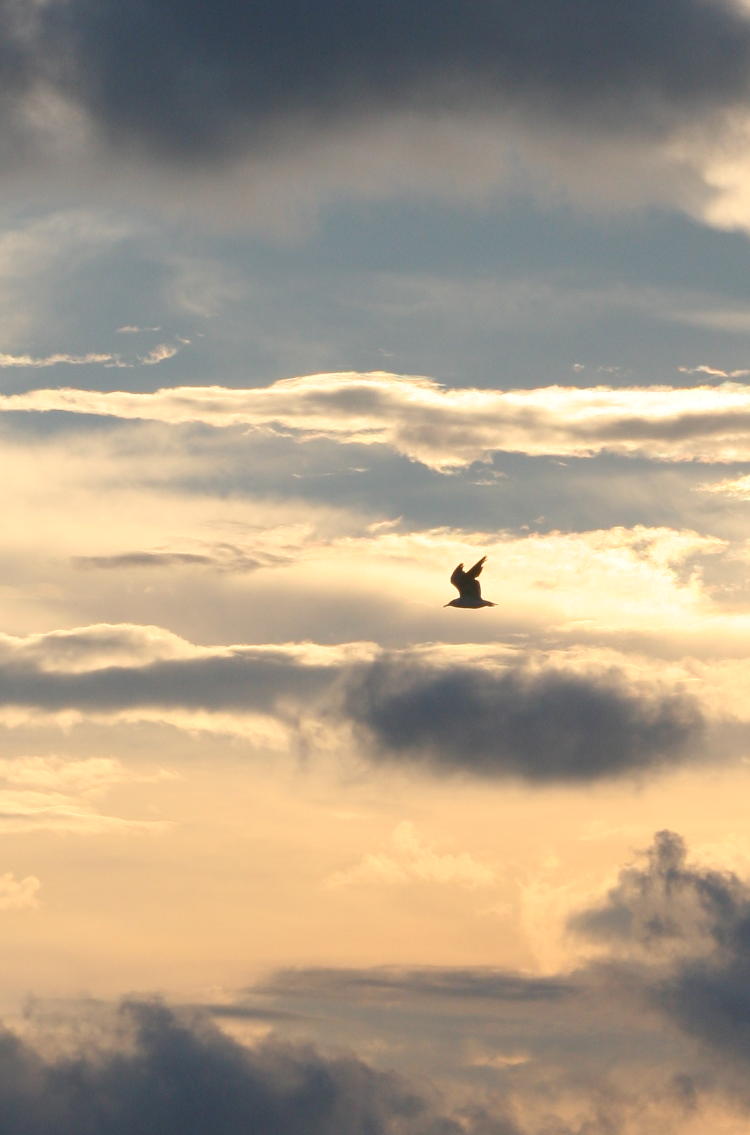
The next day we headed down to Jekyll, but rather late, so I didn’t end up doing any shooting at all until the day after (Tuesday, for those of you looking at the calendar and figuring out exactly where and when we were doing things, which I’m sure is none of you, so…) Like the previous trip, I not only got up well before sunrise to be out in a scenic location for the event, but also did a little audio recording, so those photos and such will come in a later post. For now, I will feature some of the other subjects that I happened across after chasing the sunrise… wait, “chasing the sunrise”? If you headed east, it would happen quicker, though granted it would take a hell of a velocity to make a noticeable difference. But if you traveled west at roughly 1000 kph at this latitude, you could make the sunrise last indefinitely as you counteracted the rotation of the Earth and simply remained at the point where the sun is tangent with the horizon, while all the clouds and things that make all the colors rotated through past and beneath you…
Anyway, the first shot is indeed sunrise, or a bit thereafter, the sun shrouded by denser humidity while out of the cloud banks on the horizon – this is zoomed in a little, slightly cropped from the original frame at 150mm focal length, so about what you’d see with mid-power binoculars.
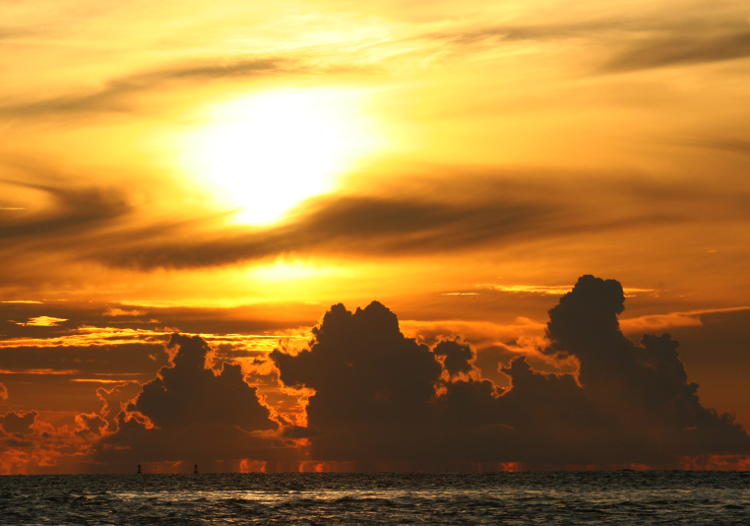
I never noticed it while shooting this, but if you look underneath the clouds, you can see the rain that’s falling someplace out at ocean, and since we can see the sunlight shining under the clouds from here, so could anyone who might have been out there, not to mention the fact that they could possibly have seen a rainbow over Jekyll Island while looking back in our direction. Off to the right out of the frame, an active thunderhead was throwing some flashes before sunrise, but it was too sporadic, and the light coming up too quickly, for me to capture any of the lightning from it. Had I been out an hour or two earlier, it might have been a decent lightshow.

Very noticeable, just about everyplace I looked, were the hermit crabs – Jekyll actually seems like an active spot for marine life. This was the nicest shell that I came across in our brief visit, but I knew from its peculiar location atop a log that it was occupied by a crab, and so I left it alone. A good percentage of the branches that would be submerged at high tide showed such holdovers, presumably waiting the five or six hours for the water to return; one overturned shell showed distinct evidence of its occupant, safely drawn in.
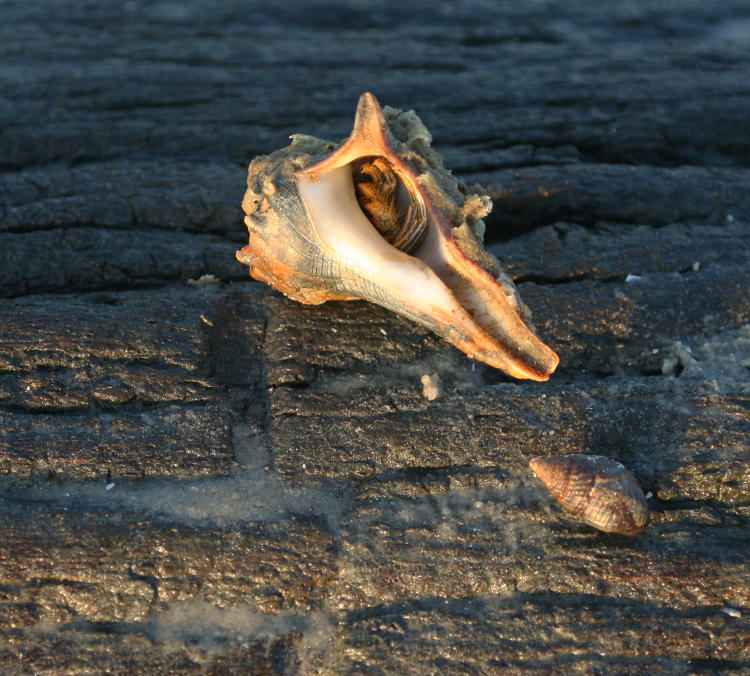
 As I said before, most of the ‘drift’wood on Jekyll isn’t – it’s all trees killed by the encroaching waters as the island is reshaped, and so anchored in place by the roots deep within the sand. As such, the advancing and receding tides form turbulence around the trunks and branches and scour out little hollows surrounding the bases, so many of the pieces of wood sit in their own private pools, while tidal pools unattached to any trees also lie scattered around the beach. Within many of these, the hermit crabs were actively wandering around, and some of the larger pools held minnows and blue crabs. I aimed down at one such hermit crab in passing, and now I wished I’d put more effort into it, because on examining the photo once I’d returned home, it appears as if the crab has a good algae growth, or perhaps some anemones – something other than smooth shell, at least. Shooting down through the surface of the water without the benefit of direct sunlight (it still being too low to shine into the pool) didn’t improve the photographic conditions any. Direct sunlight probably would have kept the crab in hiding, so a flash would have been necessary, and I’d left without the full macro kit, stupidly thinking that I’d have plenty of time to revisit such subjects.
As I said before, most of the ‘drift’wood on Jekyll isn’t – it’s all trees killed by the encroaching waters as the island is reshaped, and so anchored in place by the roots deep within the sand. As such, the advancing and receding tides form turbulence around the trunks and branches and scour out little hollows surrounding the bases, so many of the pieces of wood sit in their own private pools, while tidal pools unattached to any trees also lie scattered around the beach. Within many of these, the hermit crabs were actively wandering around, and some of the larger pools held minnows and blue crabs. I aimed down at one such hermit crab in passing, and now I wished I’d put more effort into it, because on examining the photo once I’d returned home, it appears as if the crab has a good algae growth, or perhaps some anemones – something other than smooth shell, at least. Shooting down through the surface of the water without the benefit of direct sunlight (it still being too low to shine into the pool) didn’t improve the photographic conditions any. Direct sunlight probably would have kept the crab in hiding, so a flash would have been necessary, and I’d left without the full macro kit, stupidly thinking that I’d have plenty of time to revisit such subjects.
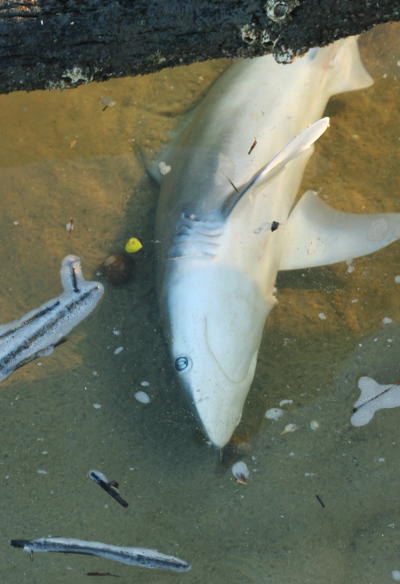 In another such pool under a branch/root/woodything, a juvenile dead shark about 35 cm long was resting – apparently this end of Jekyll is near a shark breeding ground, and this isn’t the first time that I’ve seen little ones washed ashore, though this was the largest while by no means ‘large.’ Sharks are one of the few classes of fish that I find cool, and something that I wouldn’t mind having in a large aquarium, should I ever go through the intense effort of maintaining a large saltwater tank (which isn’t likely to happen.) And this one appeared intact, though I could only see one side and didn’t bother trying to handle it. It remains possible that the shark merely got stranded by the receding tides and ran out of oxygen in its little pool, but there were some further details that lent weight to the idea that it had washed ashore dead, visible almost as soon as I’d spotted it.
In another such pool under a branch/root/woodything, a juvenile dead shark about 35 cm long was resting – apparently this end of Jekyll is near a shark breeding ground, and this isn’t the first time that I’ve seen little ones washed ashore, though this was the largest while by no means ‘large.’ Sharks are one of the few classes of fish that I find cool, and something that I wouldn’t mind having in a large aquarium, should I ever go through the intense effort of maintaining a large saltwater tank (which isn’t likely to happen.) And this one appeared intact, though I could only see one side and didn’t bother trying to handle it. It remains possible that the shark merely got stranded by the receding tides and ran out of oxygen in its little pool, but there were some further details that lent weight to the idea that it had washed ashore dead, visible almost as soon as I’d spotted it.
 A pair of hermit crabs, one of which shown here (the other can be seen as a dark spot right at the nose of the shark in the above image,) were busily scouring along the skin of the shark – which also seemed to indicate that the shark was intact, since they would have likely been working on any exposed areas which would be much easier to scavenge from. An incautious movement from me sent both hastily back into their shells, but for less than ten seconds, which is much shorter than average in my experience; my guess is the proximity of ready food overcame their cautious instincts to some extent. And none of the seagulls seemed to have found the shark’s carcass yet, which probably didn’t last out another hour, since there were scads of gulls to be seen on the beach.
A pair of hermit crabs, one of which shown here (the other can be seen as a dark spot right at the nose of the shark in the above image,) were busily scouring along the skin of the shark – which also seemed to indicate that the shark was intact, since they would have likely been working on any exposed areas which would be much easier to scavenge from. An incautious movement from me sent both hastily back into their shells, but for less than ten seconds, which is much shorter than average in my experience; my guess is the proximity of ready food overcame their cautious instincts to some extent. And none of the seagulls seemed to have found the shark’s carcass yet, which probably didn’t last out another hour, since there were scads of gulls to be seen on the beach.
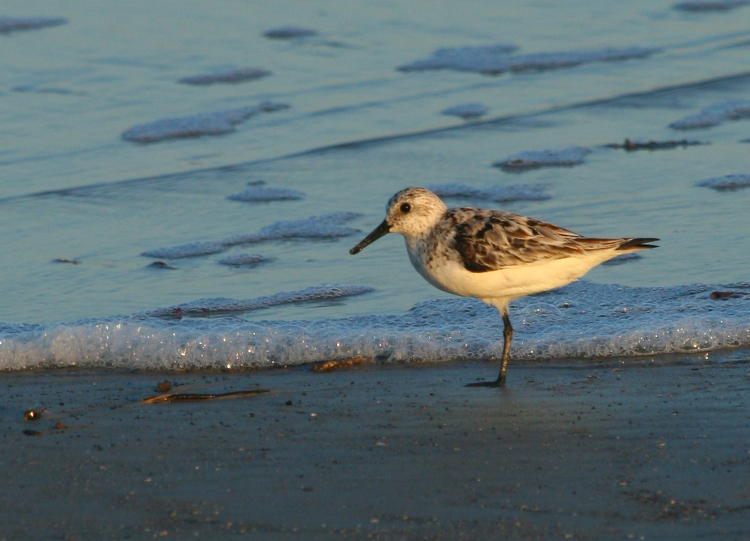
This isn’t a gull of any kind, but a sanderling (Calidris alba,) probably the most common shorebird anywhere in the region – I see them at every beach I go to, running back and forth with the surfline. Only, not this one: this one was only using one leg, and whether the other was missing, injured, or the bird was simply responding to a challenge, I cannot say – it’s easy enough for most birds to draw one leg completely within their feathers. But this one was immediately noticeable because it did not race about with the rapid, alternating footstep pace of most sandpiper-like birds, but hopped like a robin instead, and I shot countless frames of it to ensure that I was not missing anything.
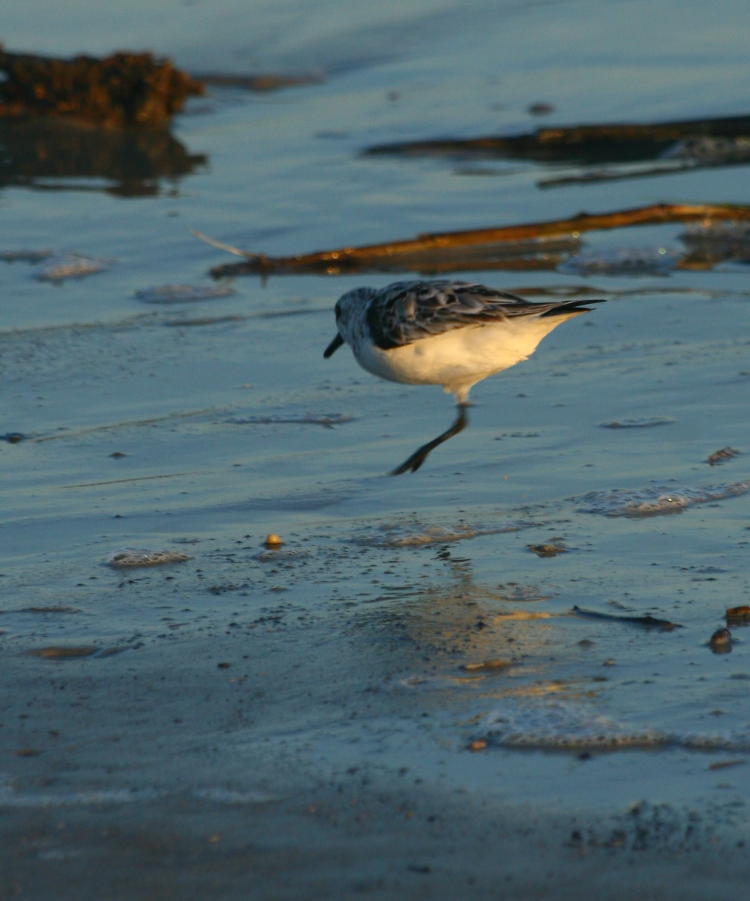
I’ve done enough wildlife rehab to know that a one-legged bird is often in trouble, partially from mobility, but mostly from its inability to shift weight off of its foot at any time, plus the added strain of balancing – they tend to develop a bedsore-like condition called bumblefoot, and it would usually lead to debilitating infections and illness. This one was showing no signs of any difficulty, however, and was gamely (a ha ha) going about its normal routine with vigor, bouncing rapidly along the waterline in search of tiny shellfish. Given that it had also demonstrated its ability to fly, I knew that, even if I could find a rehab center in the area, I wouldn’t be able to get ahold of it without a net and at least one other helper, so I left it to its own devices and trusted the soft sand to prevent it from getting foot problems.
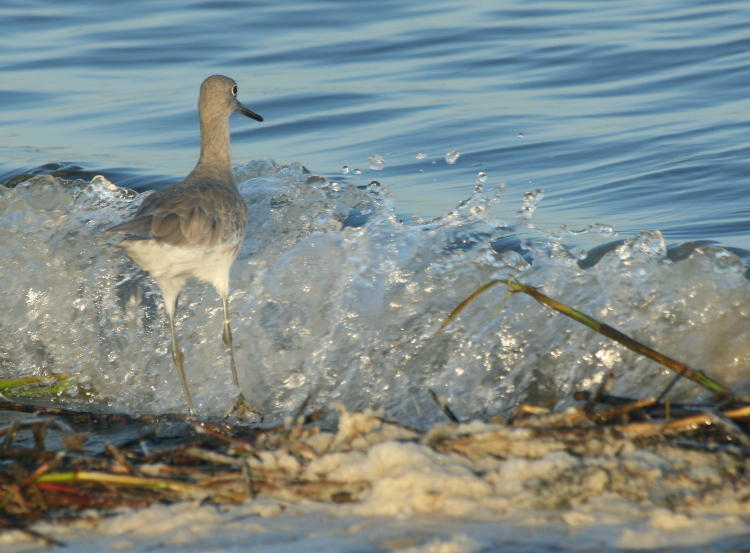
This willet (Tringa semipalmata) appeared somewhat anxious over the size of the breaker, dancing around a little uncertainly before flying off – it’s likely that it was already concerned over my proximity and not paying attention to the incoming wavelet. To me, this is faintly visible in the way the bird appears to be leaning back from the water, but having been there I don’t know if I’m imagining this being visible in the shot or not – you tell me. The previous frame to this had a lovely curl to the wave before the first hint of foam, but focus had locked onto the water and the bird was ever-so-slightly soft, and that’s enough to reject it in my book, because people are going to focus on the bird. It’s a shame really, because the wave looked really cool.

I include this to illustrate conditions more than anything, though I don’t think it’s completely without its fartistic merits (which just goes to show what I know.) For reasons unknown to me, this region seemed to have a large amount of water reeds washing ashore, so much so that the edge of the beach itself, many meters away, was liberally lined with the dried, decaying stems. Here, the gulls were foraging avidly among the plants, looking for anything that was either caught up in them or unable to scamper through the thicket back into the water. It’s possible that the channel is not terribly deep and these all get torn free from the bottom by the turbulence of passing boats, since this is a pretty busy channel, but that’s just idle speculation – the channel is certainly deep enough for the massive casino cruises that go through. Maybe the sharks pull them free when making nests. It’s conceivable that marine knowledge is not my strong suit.
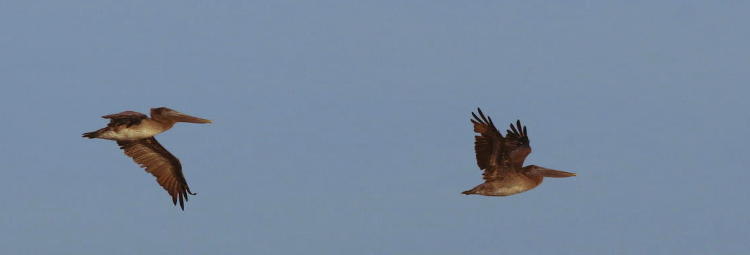
I have a side quest to get some nice detailed images of brown pelicans (Pelecanus occidentalis) in flight, which has so far managed to elude me – I have some slides from way back, but nothing recent, and every time I’ve seen some nice and close, or in great light or whatever, the camera has not been in hand; when it is, of course, they’re off in the distance doing that perfectly flat gliding thing. This is the closest that I’ve come in the past few years, and it’s not what I’m looking for, but happy morning light and good wing positions anyway.
And to close, one other from the sunrise itself, looking north to St. Simon’s Island – that’s the lighthouse to the right, which they shut down the light within way too early; I suppose I have to dub one in for the art print. This was, really, a tiny patch of sky showing the color playing off of a distinct thunderhead, while most of the rest of the sky was almost bare – this kind of cropping emphasizes what you want people to see when the full frame might make it seem much less impressive. And of course, I watched those birds come in and shot numerous frames to try and capture the best positions, and lucked out in this case (well, not entirely luck, because I knew where I wanted them and was ready when it happened.)
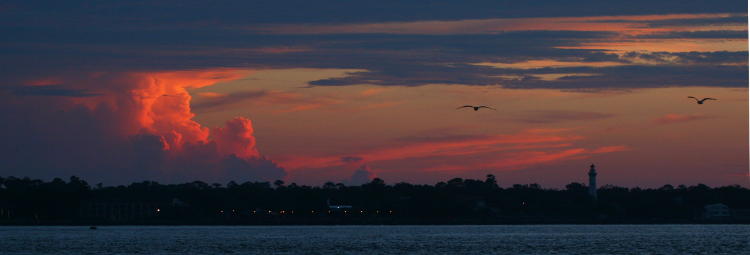
And, as I edit this draft of the post, I point out that they make great eyes to the nose of the lighthouse, and now you can’t unsee that either…





















































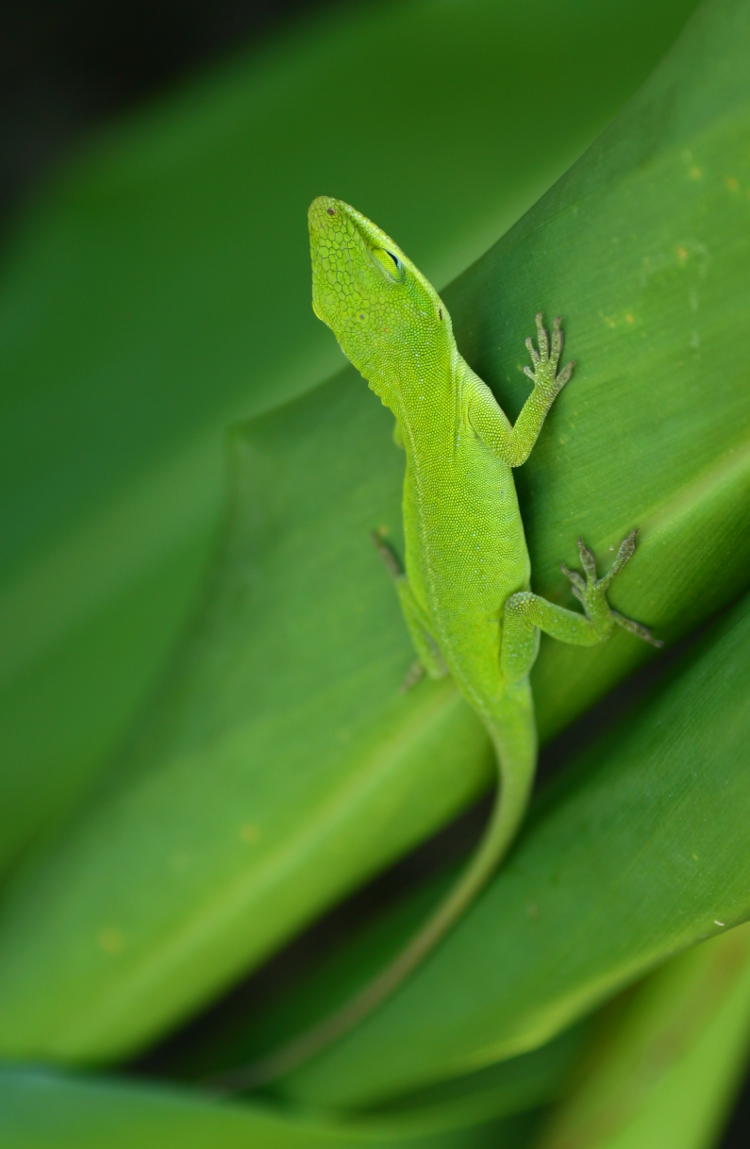
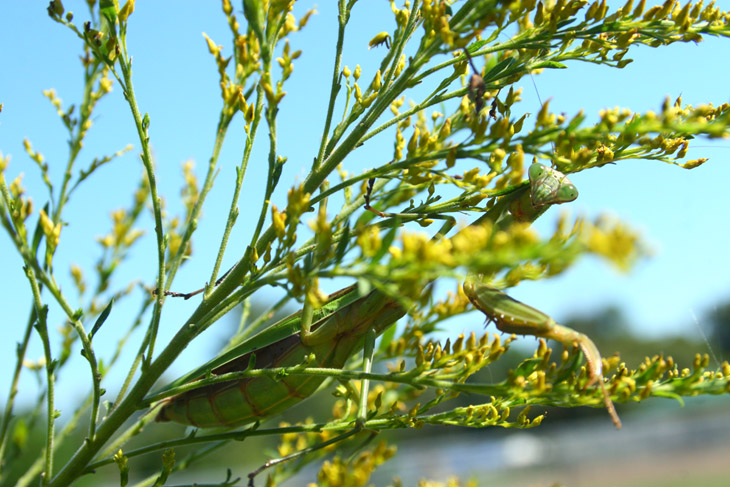
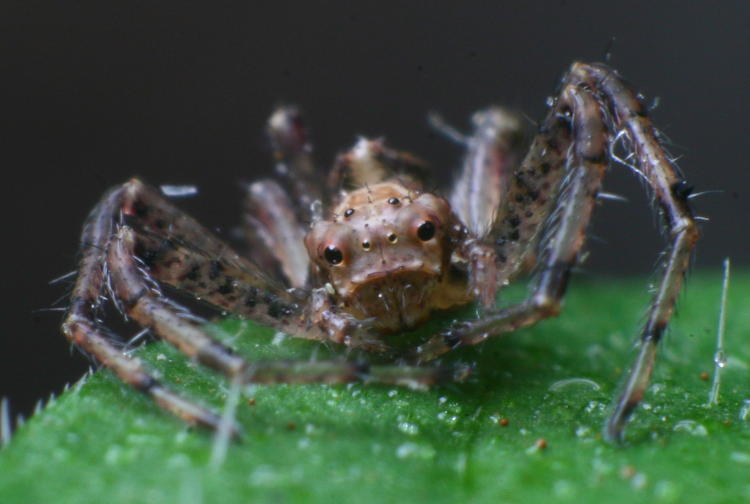

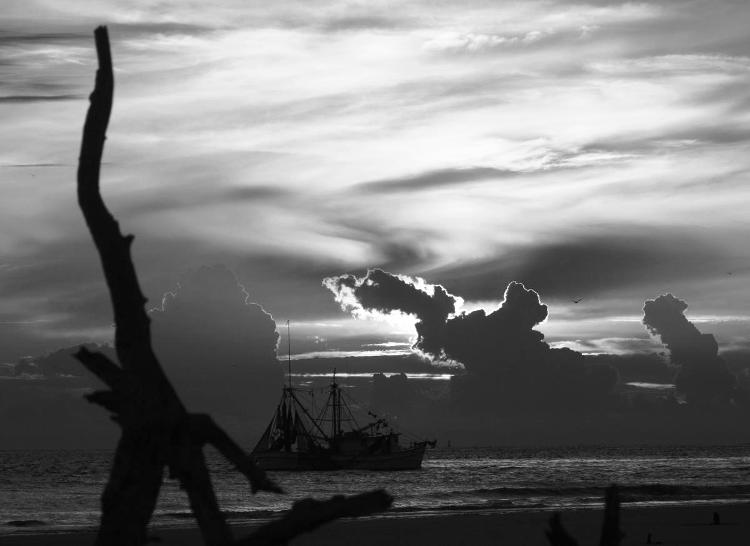


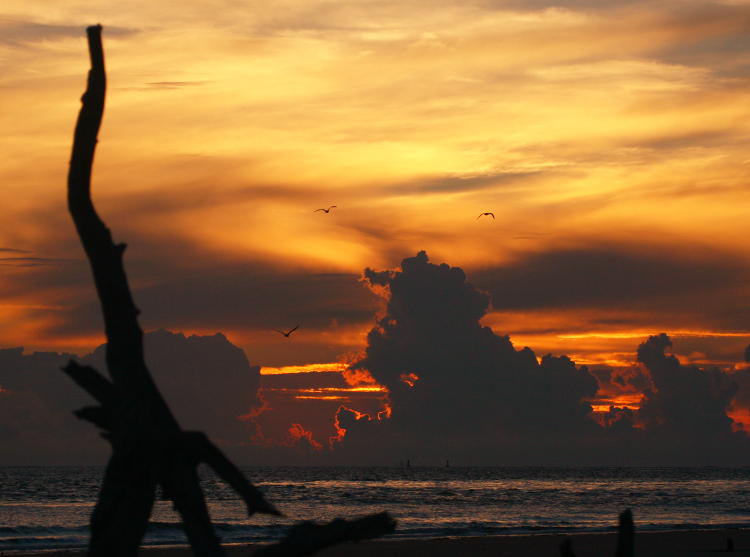
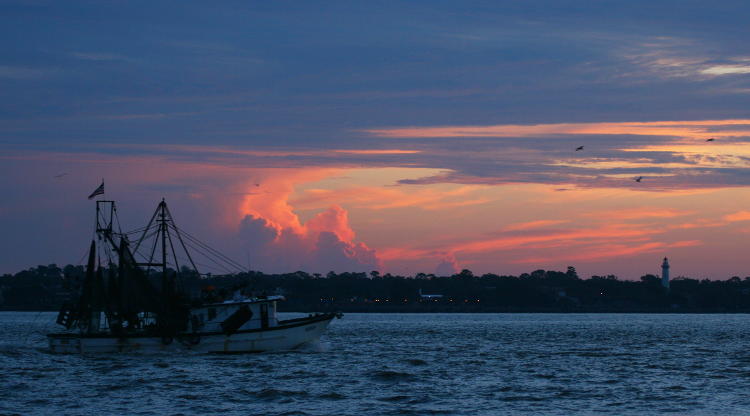

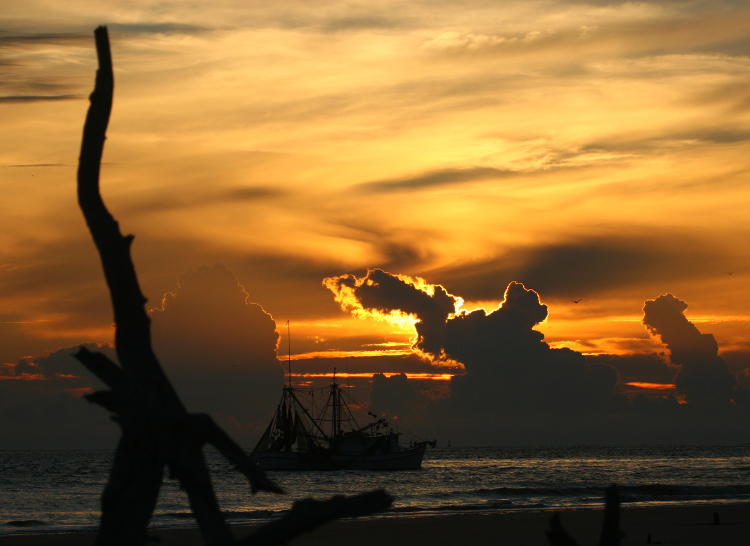
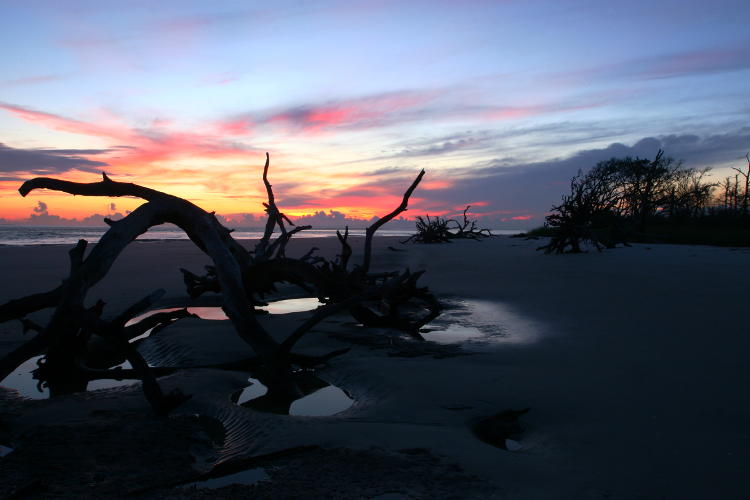
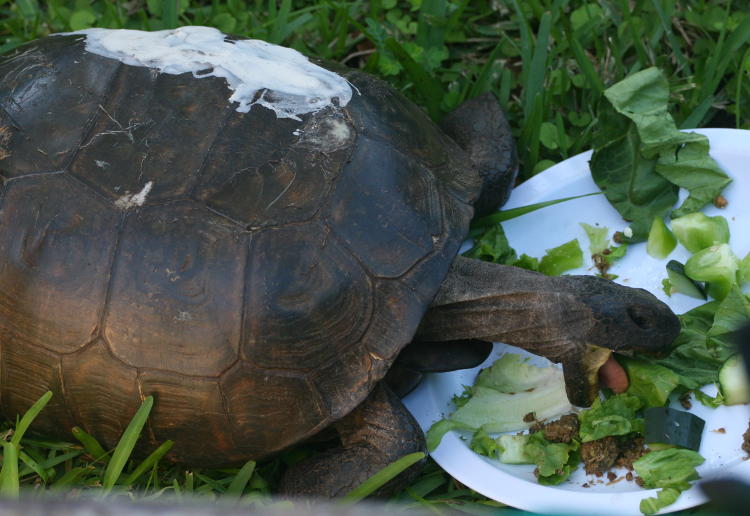
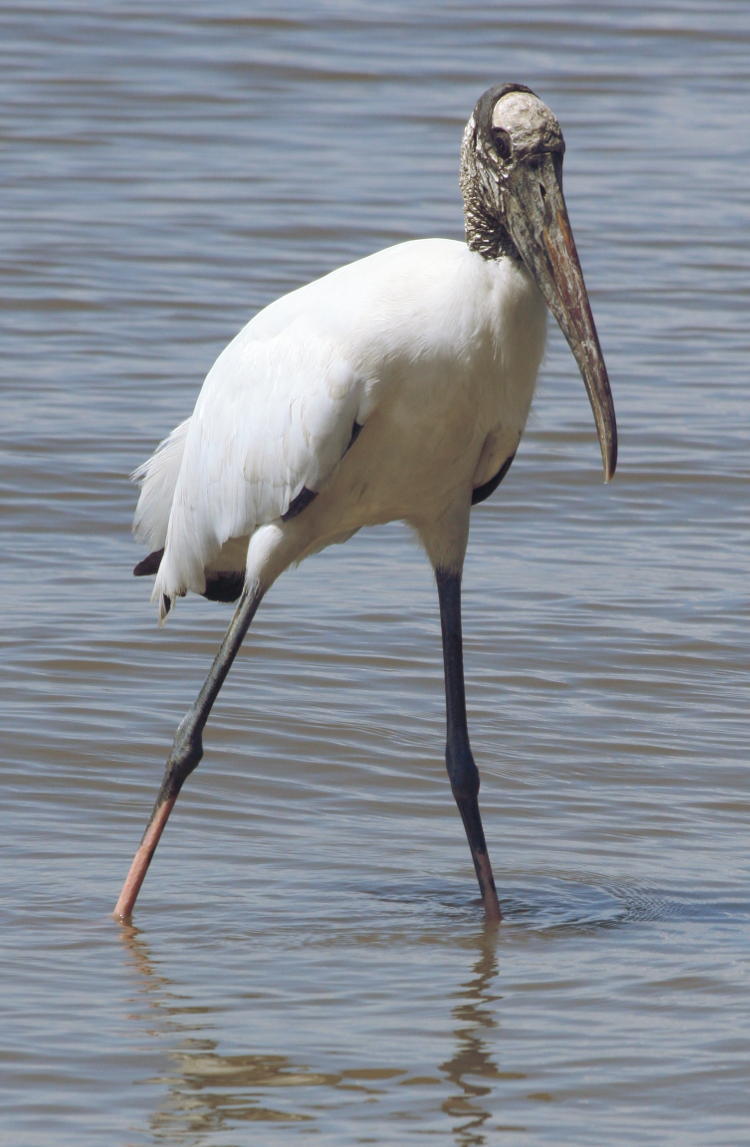
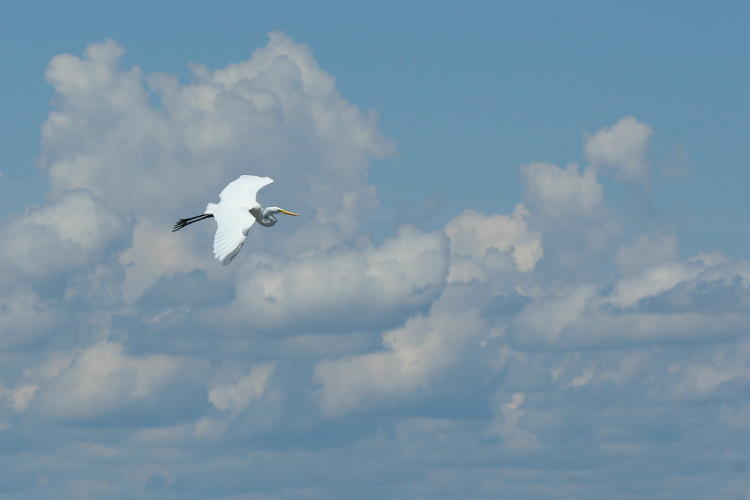
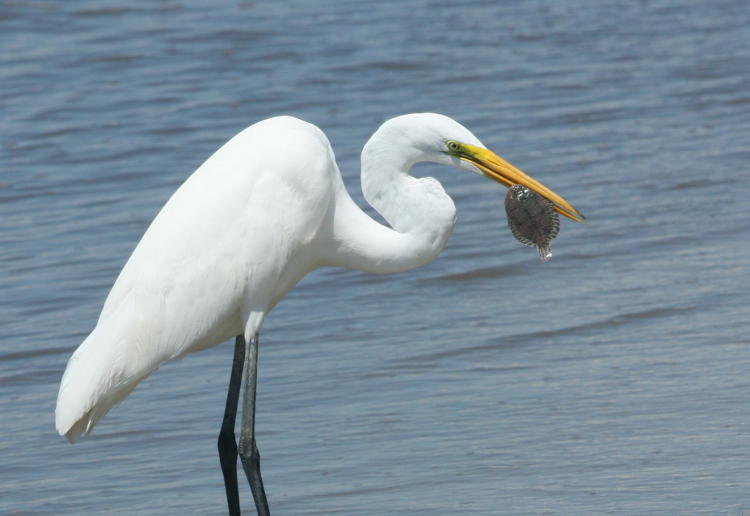
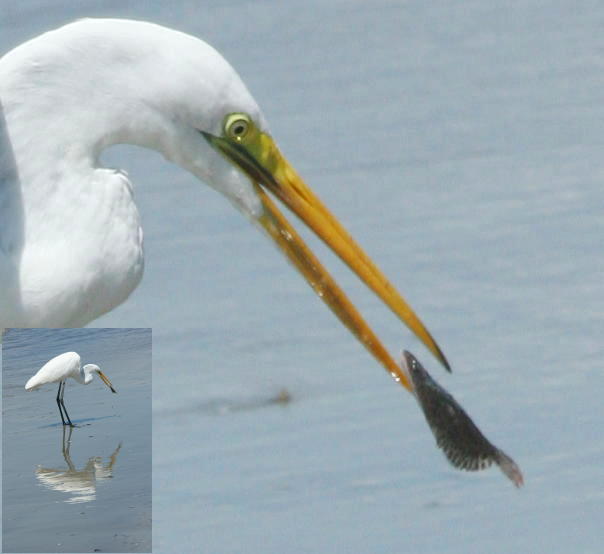
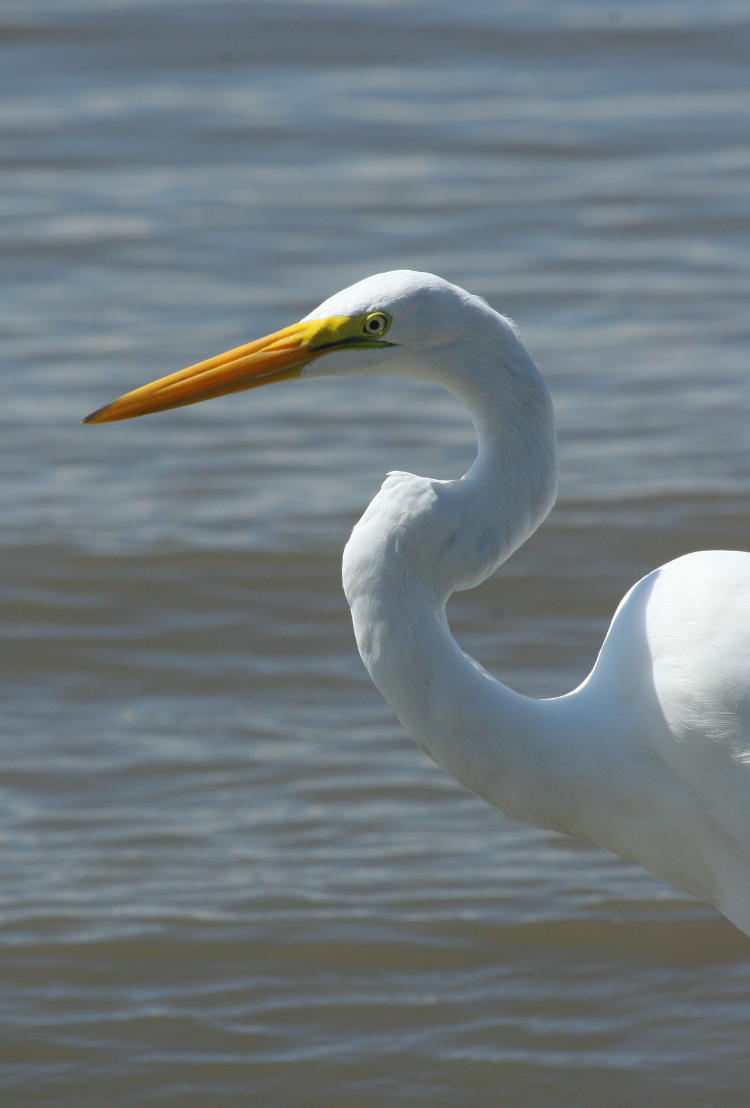

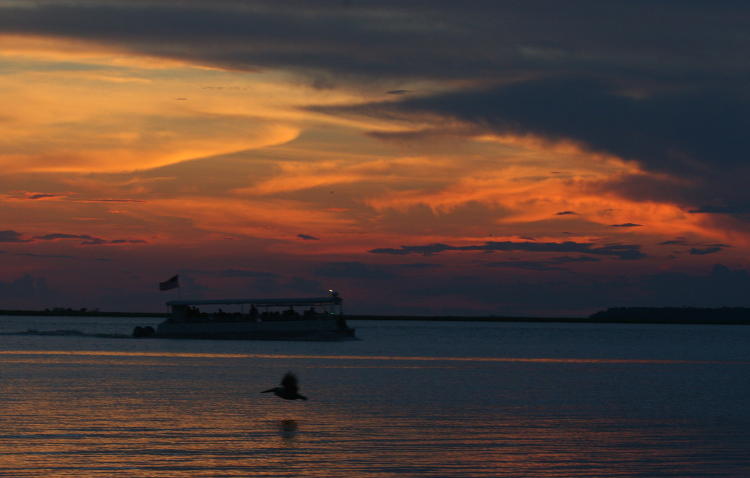
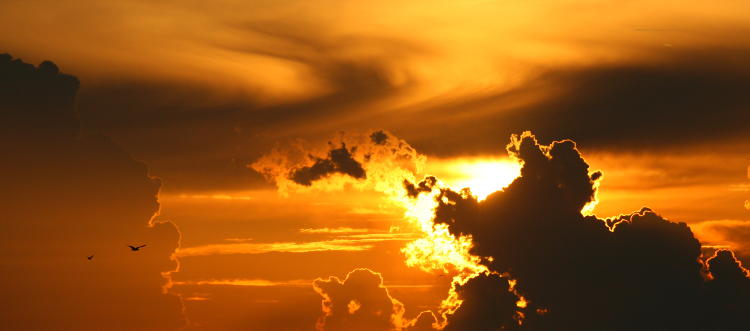



 The “us” in this case is The Girlfriend, The Girlfriend’s Sprog, and I, and the locale is outside of Savannah, Georgia, because this past week was our scheduled trip to Savannah and Jekyll Island. It was intended to be just shy of an entire week, Saturday to Friday, but Hurricane Florence changed that as it strengthened and aimed for the coast, and we spent a lot of time debating whether our plans would change, and in what way. I have to point out that last year’s scheduled trip to the same places was canceled outright due to Hurricane Irma’s landfall directly on Jekyll, which closed the island, so this was starting to get annoying. And yes, feel free to blame us for picking these times, but there’s more than casual reasoning behind it: the goal was to catch sea turtle hatching season, which occurs for about six weeks right around this time, plus we’d aimed for after Labor Day to take advantage of lower rates, lesser crowds, and better traffic. But yeah, it seems we’ve learned our lesson now. It doesn’t help that, as I type this back home in North Carolina, Florence (now a Tropical Storm,) is centered fewer than 200 kilometers away and producing less rain and winds than some of the spring storms this year. I’m sure some areas are catching it a lot worse, but not where we were or on our return path; we could have ignored the storm and not seen anything except for some rainy driving on the trip back, but there was no way we could have known that for sure. The news reports concentrated on the dramatic aspects and not on an accurate picture of what was really happening, surprise surprise.
The “us” in this case is The Girlfriend, The Girlfriend’s Sprog, and I, and the locale is outside of Savannah, Georgia, because this past week was our scheduled trip to Savannah and Jekyll Island. It was intended to be just shy of an entire week, Saturday to Friday, but Hurricane Florence changed that as it strengthened and aimed for the coast, and we spent a lot of time debating whether our plans would change, and in what way. I have to point out that last year’s scheduled trip to the same places was canceled outright due to Hurricane Irma’s landfall directly on Jekyll, which closed the island, so this was starting to get annoying. And yes, feel free to blame us for picking these times, but there’s more than casual reasoning behind it: the goal was to catch sea turtle hatching season, which occurs for about six weeks right around this time, plus we’d aimed for after Labor Day to take advantage of lower rates, lesser crowds, and better traffic. But yeah, it seems we’ve learned our lesson now. It doesn’t help that, as I type this back home in North Carolina, Florence (now a Tropical Storm,) is centered fewer than 200 kilometers away and producing less rain and winds than some of the spring storms this year. I’m sure some areas are catching it a lot worse, but not where we were or on our return path; we could have ignored the storm and not seen anything except for some rainy driving on the trip back, but there was no way we could have known that for sure. The news reports concentrated on the dramatic aspects and not on an accurate picture of what was really happening, surprise surprise.
 Those are the original lighthouse complex buildings in the foreground, with Fort Screven in the middle ground and the historic Atlantic Ocean in the rear. Somewhere off to the far right (not the photo to the immediate right) sits a nuclear bomb, jettisoned from a bomber back in 1958, but we didn’t get to see that.
Those are the original lighthouse complex buildings in the foreground, with Fort Screven in the middle ground and the historic Atlantic Ocean in the rear. Somewhere off to the far right (not the photo to the immediate right) sits a nuclear bomb, jettisoned from a bomber back in 1958, but we didn’t get to see that. 
 While shooting it with the 100-300 L lens, some birds helpfully played around in the frame, lending some points of interest and ‘setting’ to the sky. Attempting these kinds of compositions can be a little taxing to anyone you’re hanging with, especially if they’re not trying for the same thing, because while plenty of birds might be flying around, having one pass precisely through the prime portion of the frame is difficult enough, but having the light right and the wings in a good position is strictly hit-or-miss, much more often miss. Trust me – I did it enough on this trip. You never realize how easy it is for a bird to be in a cluttered portion of the frame, or in a boring flat glide right when you want the wings up, until you’re patiently waiting for them to fill out your intended composition. But while you’re staring through the viewfinder or watching the birds within the immediate vicinity, thinking, Any second now, your companions are watching you shoot nothing and wondering how much longer this is going to take. “C’mon, you can shoot nothing from home!”
While shooting it with the 100-300 L lens, some birds helpfully played around in the frame, lending some points of interest and ‘setting’ to the sky. Attempting these kinds of compositions can be a little taxing to anyone you’re hanging with, especially if they’re not trying for the same thing, because while plenty of birds might be flying around, having one pass precisely through the prime portion of the frame is difficult enough, but having the light right and the wings in a good position is strictly hit-or-miss, much more often miss. Trust me – I did it enough on this trip. You never realize how easy it is for a bird to be in a cluttered portion of the frame, or in a boring flat glide right when you want the wings up, until you’re patiently waiting for them to fill out your intended composition. But while you’re staring through the viewfinder or watching the birds within the immediate vicinity, thinking, Any second now, your companions are watching you shoot nothing and wondering how much longer this is going to take. “C’mon, you can shoot nothing from home!”



 As I said before, most of the ‘drift’wood on Jekyll isn’t – it’s all trees killed by the encroaching waters as the island is reshaped, and so anchored in place by the roots deep within the sand. As such, the advancing and receding tides form turbulence around the trunks and branches and scour out little hollows surrounding the bases, so many of the pieces of wood sit in their own private pools, while tidal pools unattached to any trees also lie scattered around the beach. Within many of these, the hermit crabs were actively wandering around, and some of the larger pools held minnows and blue crabs. I aimed down at one such hermit crab in passing, and now I wished I’d put more effort into it, because on examining the photo once I’d returned home, it appears as if the crab has a good algae growth, or perhaps some anemones – something other than smooth shell, at least. Shooting down through the surface of the water without the benefit of direct sunlight (it still being too low to shine into the pool) didn’t improve the photographic conditions any. Direct sunlight probably would have kept the crab in hiding, so a flash would have been necessary, and I’d left without the full macro kit, stupidly thinking that I’d have plenty of time to revisit such subjects.
As I said before, most of the ‘drift’wood on Jekyll isn’t – it’s all trees killed by the encroaching waters as the island is reshaped, and so anchored in place by the roots deep within the sand. As such, the advancing and receding tides form turbulence around the trunks and branches and scour out little hollows surrounding the bases, so many of the pieces of wood sit in their own private pools, while tidal pools unattached to any trees also lie scattered around the beach. Within many of these, the hermit crabs were actively wandering around, and some of the larger pools held minnows and blue crabs. I aimed down at one such hermit crab in passing, and now I wished I’d put more effort into it, because on examining the photo once I’d returned home, it appears as if the crab has a good algae growth, or perhaps some anemones – something other than smooth shell, at least. Shooting down through the surface of the water without the benefit of direct sunlight (it still being too low to shine into the pool) didn’t improve the photographic conditions any. Direct sunlight probably would have kept the crab in hiding, so a flash would have been necessary, and I’d left without the full macro kit, stupidly thinking that I’d have plenty of time to revisit such subjects. In another such pool under a branch/root/woodything, a juvenile dead shark about 35 cm long was resting – apparently this end of Jekyll is near a shark breeding ground, and this isn’t the first time that I’ve seen little ones washed ashore, though this was the largest while by no means ‘large.’ Sharks are one of the few classes of fish that I find cool, and something that I wouldn’t mind having in a large aquarium, should I ever go through the intense effort of maintaining a large saltwater tank (which isn’t likely to happen.) And this one appeared intact, though I could only see one side and didn’t bother trying to handle it. It remains possible that the shark merely got stranded by the receding tides and ran out of oxygen in its little pool, but there were some further details that lent weight to the idea that it had washed ashore dead, visible almost as soon as I’d spotted it.
In another such pool under a branch/root/woodything, a juvenile dead shark about 35 cm long was resting – apparently this end of Jekyll is near a shark breeding ground, and this isn’t the first time that I’ve seen little ones washed ashore, though this was the largest while by no means ‘large.’ Sharks are one of the few classes of fish that I find cool, and something that I wouldn’t mind having in a large aquarium, should I ever go through the intense effort of maintaining a large saltwater tank (which isn’t likely to happen.) And this one appeared intact, though I could only see one side and didn’t bother trying to handle it. It remains possible that the shark merely got stranded by the receding tides and ran out of oxygen in its little pool, but there were some further details that lent weight to the idea that it had washed ashore dead, visible almost as soon as I’d spotted it. A pair of hermit crabs, one of which shown here (the other can be seen as a dark spot right at the nose of the shark in the above image,) were busily scouring along the skin of the shark – which also seemed to indicate that the shark was intact, since they would have likely been working on any exposed areas which would be much easier to scavenge from. An incautious movement from me sent both hastily back into their shells, but for less than ten seconds, which is much shorter than average in my experience; my guess is the proximity of ready food overcame their cautious instincts to some extent. And none of the seagulls seemed to have found the shark’s carcass yet, which probably didn’t last out another hour, since there were scads of gulls to be seen on the beach.
A pair of hermit crabs, one of which shown here (the other can be seen as a dark spot right at the nose of the shark in the above image,) were busily scouring along the skin of the shark – which also seemed to indicate that the shark was intact, since they would have likely been working on any exposed areas which would be much easier to scavenge from. An incautious movement from me sent both hastily back into their shells, but for less than ten seconds, which is much shorter than average in my experience; my guess is the proximity of ready food overcame their cautious instincts to some extent. And none of the seagulls seemed to have found the shark’s carcass yet, which probably didn’t last out another hour, since there were scads of gulls to be seen on the beach.





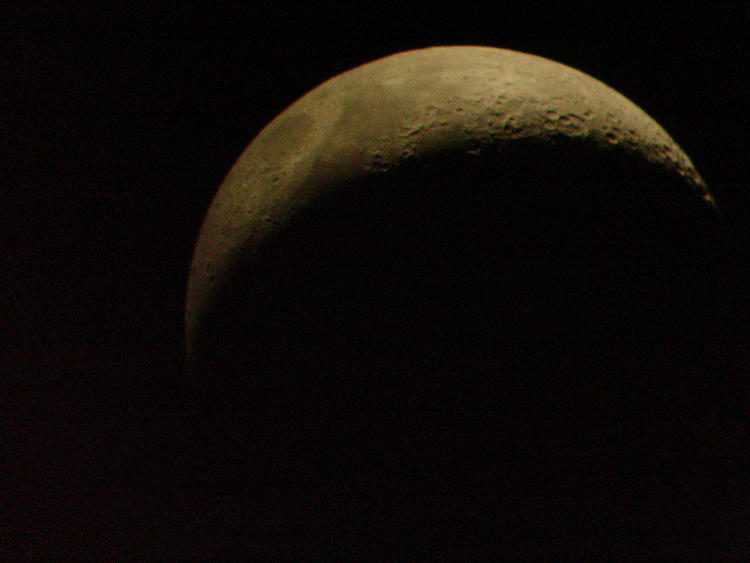
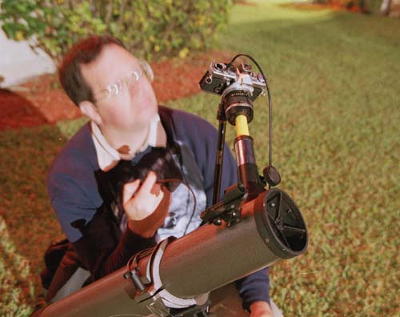 Then there’s light attenuation because of not just the scope itself, but whatever adapter is necessary to affix a camera. Consumer telescopes of nearly all types only have to provide an image through our tiny little eyes and are optimized for such, both in focal length and in ‘exit pupil,’ the actual size of the projected image at focus. Naturally, a 35mm film frame (which is what I originally adapted for) is a lot larger than our pupils or retinas, but it’s the same amount of light coming through the eyepiece of the scope, so it has to be spread out more to cover that frame, thus the whole image gets a lot darker. To that we add focal distance, because telescopes are optimized for the lenses of our eyes and the ‘effective’ focus of them to a couple of meters away for comfort (meaning when we focus on an image in a telescope or binoculars, we’re focusing the same as we would for an object a few meters away,) while the camera is going to be different. All of this usually means extra tubes from the eyepiece and often additional lenses too, see here in my homemade rig: the yellow tube is an old metal broomhandle the right size to lock into the eyepiece extension of the scope, glued to a rear lens cap with a hole precisely drilled into it, which it itself attached to a reversed 35mm lens, attached to the camera with a reversing ring. All of that reduces the light getting to the image.
Then there’s light attenuation because of not just the scope itself, but whatever adapter is necessary to affix a camera. Consumer telescopes of nearly all types only have to provide an image through our tiny little eyes and are optimized for such, both in focal length and in ‘exit pupil,’ the actual size of the projected image at focus. Naturally, a 35mm film frame (which is what I originally adapted for) is a lot larger than our pupils or retinas, but it’s the same amount of light coming through the eyepiece of the scope, so it has to be spread out more to cover that frame, thus the whole image gets a lot darker. To that we add focal distance, because telescopes are optimized for the lenses of our eyes and the ‘effective’ focus of them to a couple of meters away for comfort (meaning when we focus on an image in a telescope or binoculars, we’re focusing the same as we would for an object a few meters away,) while the camera is going to be different. All of this usually means extra tubes from the eyepiece and often additional lenses too, see here in my homemade rig: the yellow tube is an old metal broomhandle the right size to lock into the eyepiece extension of the scope, glued to a rear lens cap with a hole precisely drilled into it, which it itself attached to a reversed 35mm lens, attached to the camera with a reversing ring. All of that reduces the light getting to the image.
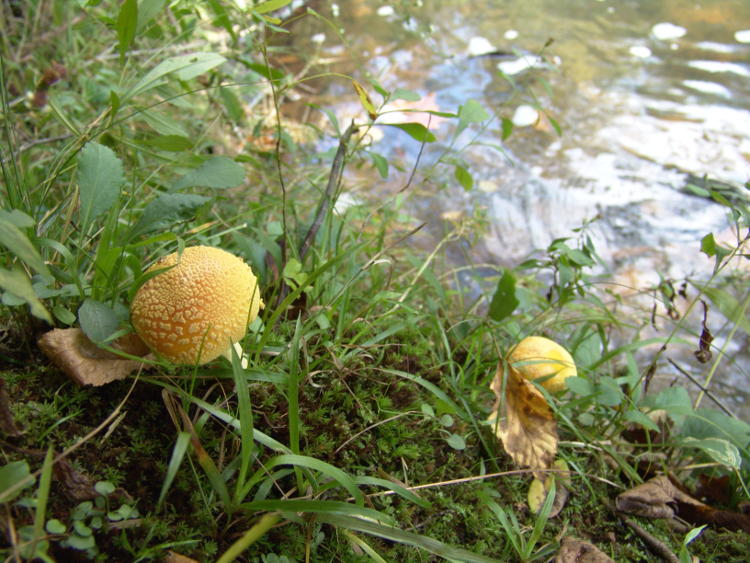

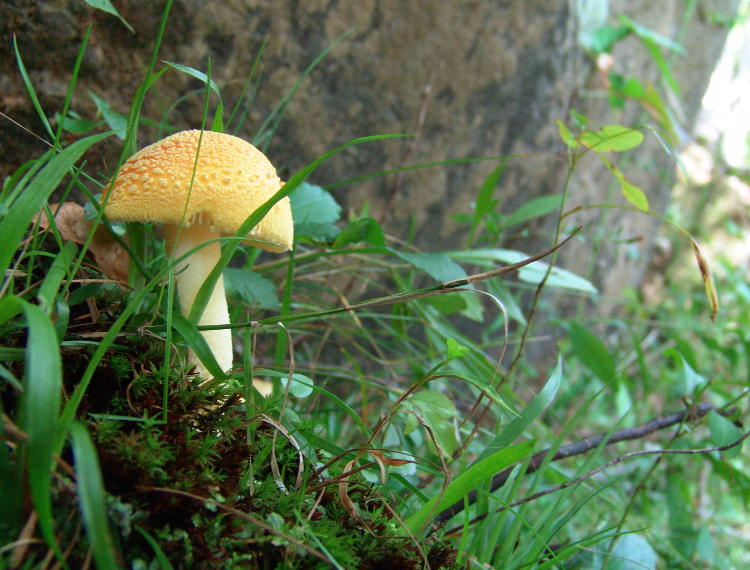

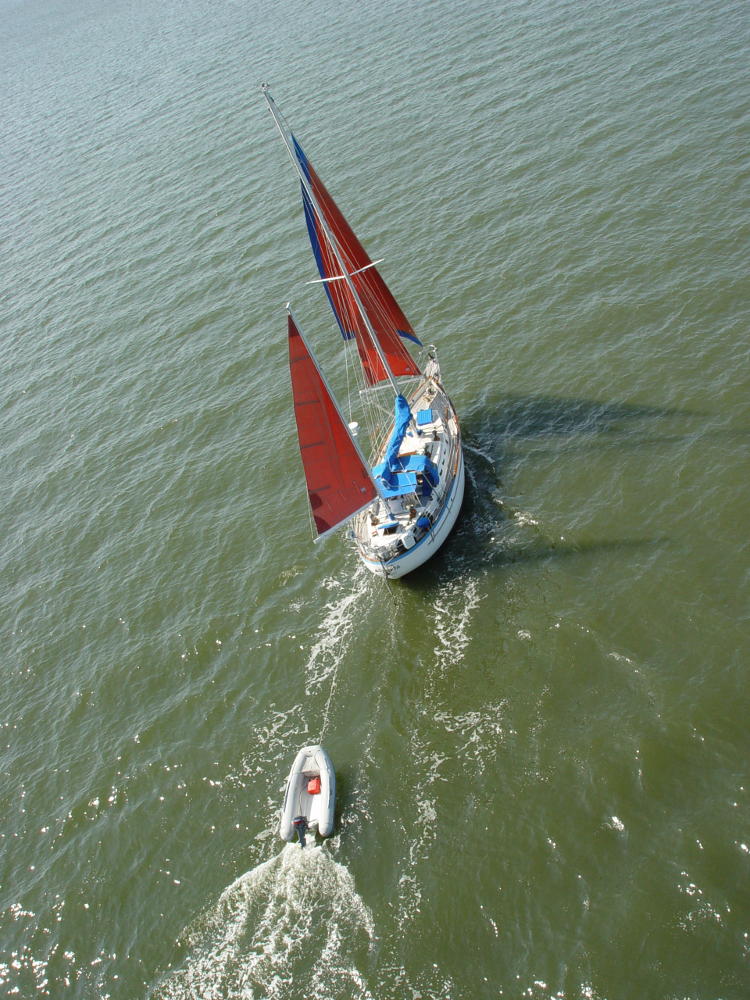
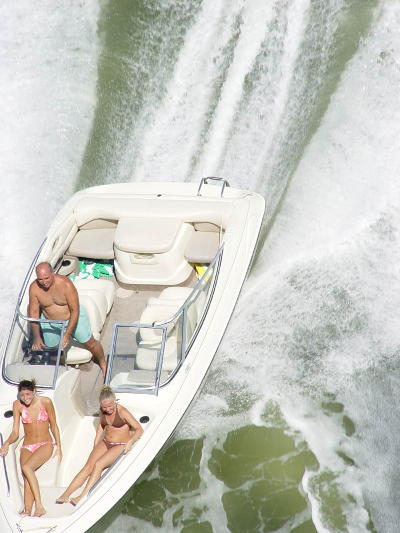 Another time in the exact same location, I was looking out over the water for dolphins and manatees and whatever else I might spot from the high vantage – I’d seen some big jellyfish, manta and cownose rays, and even some sea turtles from up there – when one of the occupants of a boat passing beneath spotted the camera in my hands, squealed and waved. I quickly aimed down and fired off a shot, the haste partially evidenced by the lousy framing, but I had a bare second before the boat would have disappeared under the bridge. That she wasn’t really trying to have her picture taken is proved by her embarrassed smile here – I suspect she thought I was slower than that, which tells how out-of-touch she was in not recognizing me and my awesome photographic reputation.
Another time in the exact same location, I was looking out over the water for dolphins and manatees and whatever else I might spot from the high vantage – I’d seen some big jellyfish, manta and cownose rays, and even some sea turtles from up there – when one of the occupants of a boat passing beneath spotted the camera in my hands, squealed and waved. I quickly aimed down and fired off a shot, the haste partially evidenced by the lousy framing, but I had a bare second before the boat would have disappeared under the bridge. That she wasn’t really trying to have her picture taken is proved by her embarrassed smile here – I suspect she thought I was slower than that, which tells how out-of-touch she was in not recognizing me and my awesome photographic reputation.